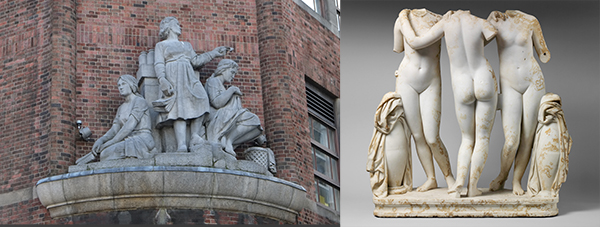The Three Graces
Published in Features, Issue 4 (July/August 2016), Volume 24
Above: Gabriel Hayes’sThe Three Graces on the façade depicts three women engaged in routine domestic activities, a variation on the classical sculpture of Zeus’s daughters (inset: Rome, second century AD). (Peter Griffin; Metropolitan Museum of Art, NY)
The notion that a woman’s primary responsibility to society was to be a home-maker was encompassed in the founding ethos of St Mary’s College. Indeed, to underline this point, the exquisite sculpture placed at the building’s façade two years after its opening, known as The Three Graces and designed by Gabriel Hayes, depicts three women doing routine domestic activities, including sweeping, spinning and sewing.
The design brief given to Hayes was that the sculpture was to reflect the ‘instructional work’ of the college, and she interpreted this to create a stunning variation on the classical sculpture of Zeus’s daughters. Hayes’s Three Graces defined through art both the confessional nature of the Irish state and an educational establishment that was dedicated to ‘women’s work’. In the highly informative ‘Modern Ireland in 100 Artworks’ series by the Irish Times, Paula Murphy observed:
‘Hayes’s depiction of femininity—she modelled the life-size figures on friends—was unusual in public sculpture in the first half of the twentieth century. Her clothed, active variation on The Three Graces is markedly different from classical representations, where the three women—daughters of Zeus, representing creativity, charm and beauty—are shown nude, with little more than their attributes, such as apples, myrtle and dice, to hand. Sculptures of nude women would not appear on buildings in Dublin for another fifty years. The girls in the sculpture on Cathal Brugha Street are accompanied by more mundane and practical attributes, including a brush and a sewing basket. Referred to occasionally also as The Three Fates, Hayes’s sculpture, on a building dedicated to so-called women’s work, might well have been loosely interpreted in this way. In Greek mythology the Fates were the weavers of destiny—in this instance the destiny of women to have their lives associated with domestic work.’
















